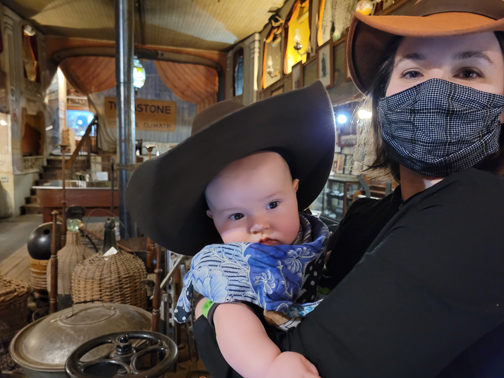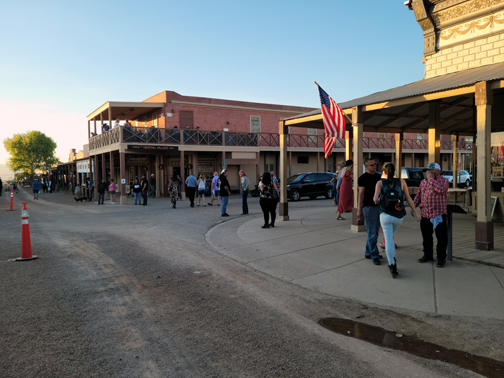
Walking on Allen Street, the main drag in Tombstone.
By Charly SHELTON
By 1929, the Wild West was largely tamed. The gunfights had ceased, law was prevalent in towns and cities across the country, the telephone helped information spread faster than a horse could run or a new-fangled automobile could drive. The boomtowns of Tombstone and Dodge City that are etched into America’s zeitgeist slowly began to shrivel and die. But then something happened that changed their fate — kids got ahold of it. Children of the ’20s and ’30s heard the tales their parents and grandparents told of cowboys and Indians. Radio programs romanticized the white hat versus black hat dramas of the West. Travelling shows like Buffalo Bill’s Wild West and the Ford Brothers Who Murdered Jesse James showed off skills and reenactments of famous events. And pulp novels, which had been spinning fantastic tales of the heroes and villains of the Wild West while they were happening, created a pantheon of Western stars and characters that were ripe for adaptation to the new medium that was taking the world by storm, the motion picture.
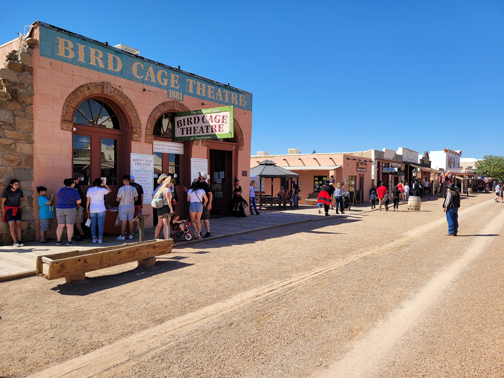
By 1929, the Wild West was a show that attracted tourists. To mark the 50th anniversary of the founding of Tombstone, Arizona a celebration was held in which the founding pioneers and notable residents were invited back to town for a big parade, reenacted gunfights, a mock hanging and more. This was held the third weekend of October 1929, and has been held that time every year since.
CV Weekly was on hand in Tombstone this year to see the gunfights, the town and the raucous crowds spilling out of the saloons just like it was in the 1880s. Even in the midst of this COVID-19 pandemic, Tombstone is “the town too tough to die.” But, just like the Wyatt Earps and Doc Hollidays of the West, heroes who stand up to villains but are themselves still murderers, there are two sides to this year’s Helldorado Days. We have endeavored to showcase the good and the bad of this festival, and many like it going forward in the pandemic world.
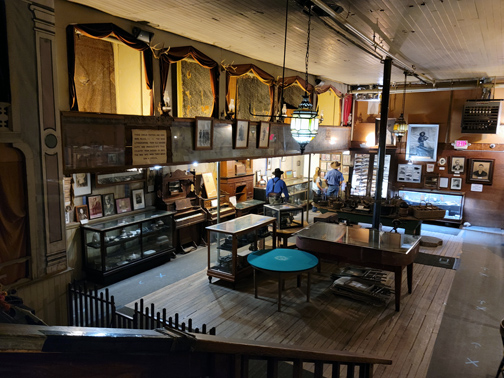
On the upside, I love the gunfights and the saloon girls and the regular people from all across the country coming in to this small town to dress up like old time gentlemen and outlaws, just to play for a few days. It’s like Disneyland for adults, but set within real history. Sure the gunfighters use blanks and the wood buildings have turned from prostitution dens to T-shirt shops, but you can feel the history here. And during Helldorado Days, history seems close enough to touch. Historians lead talks and tours, everyone wears a wide-brimmed hat, many wear real pistols at their side, and people standing in the street look like they’ve just stepped out of a saloon that hasn’t closed in over 100 years – because they haven’t. The Crystal Palace has been around since the boomtown days of the 1880s and hasn’t closed its doors for more than a day since. And the Oriental Saloon has recently reopened as a bar, after having been gift shops for many decades. The Oriental is where Wyatt Earp dealt Faro and owned a quarter interest in the game during his time there. Today guests can belly up to the same bar that the cowboys and lawmen did back in that era. Sure, we’re drinking Bud Light more than whiskey now but it still has that air of a raucous saloon that one would feel back in the day. There’s something magical about the town being so alive with people. With these many visitors, it feels like it would have in the heyday of the boomtown when people from around the country rolled in to make their fortunes and, on a Friday night around payday, these saloons would be just as packed and lively with entertainment and drinking. Let’s just hope Arizona’s open carry gun laws are better enforced now than they were back then.
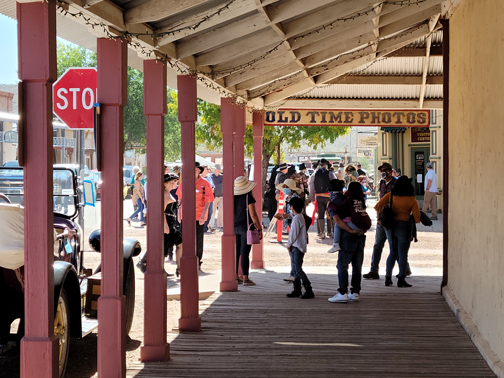
But there is a downside. I spent every summer as a kid and teenager working with my uncle in Tombstone. I grew up on these streets, running around to see gunfights and socializing with drifters and cowboy musicians who rolled through town. I love this town. So it’s conflicting for me to see so many people there for Helldorado Days. I’m glad that the businesses are getting traffic and patronage in a time when many small businesses haven’t been so lucky. But the flipside is that the traffic comes during a pandemic. Hardly anyone wore masks during Helldorado Days, social distance was the width of a cowboy hat’s brim and nobody seemed to mind. Guests in shops touched everything, handling items and inspecting them close enough to breathe on, then maybe trying something on before shaking their head and putting the item back. I never used to be conscious of any of this stuff before the pandemic.
When I worked summers there, it was in an old-time photo studio, dressing guests in cowboy and saloon girl attire to pose for sepia-toned pictures in paper wanted sign frames. To think now of how many people would pass through that hat in a day, how many handled that pistol after a hot day of walking around, I can’t imagine what we must have come in contact with. And now with COVID-19 lurking, I am mortified. It’s not that I’m afraid of the virus itself, but the environment of the post-quarantine world we live in has made me more aware of all the unsanitary practices we called normal before February 2020. As guests’ lives return to normal, their behavior returns to normal as well. I just don’t know if we as a culture, and I personally, should and will be aware of these unsanitary practices for a long time to come.
